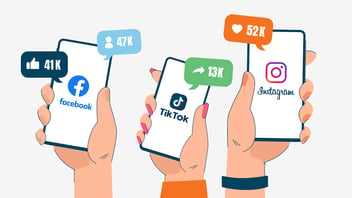"What's your Instagram?"
If you've ever been asked this question, then you've been asked for your social media handle.
Handles are unique usernames attached to our profiles across various social media platforms. They have changed the way we interact, share information, and connect with each others online, even outside of social media. Whether you’re an individual, a business, or a public figure, your handle becomes a representation of your online identity. You'll want to choose wisely!
In this article, we'll walk through everything you need to know about social media handles, including:
- Social media handle meaning, and the origin of the word
- Username rules on every social media platforms, covering character allowances and length and if you can change your social media handle
- How to choose a great social media handle
- Whether you can change your social media handle
- The impact of social media handles on your brand
Let's get started.
What is a social media handle?
A social media handle is the username that individuals, businesses, and organizations use to identify their accounts on various social media platforms. It’s often preceded by the @ symbol, e.g. @username. This allows users to tag, mention, or search for specific profiles within a given platform. "Handle" and "username" mean the same thing and can be used interchangeably, though most of the social media platforms default to the word "username" in their user experiences.
Usernames, or handles, are meant to be an easily recognizable way to identify and locate individuals or entities on social media platforms, like a calling card. They are first come, first served, which means they are unique to a single user on each social media platform — two people cannot have the same handle on Instagram, for example. However, one person's Instagram handle might be the same as someone else's TikTok handle.
Your handle is one of the first things people see when they interact with your account, whether it's on your profile, on one of your posts, in a comment you left, or in a DM. Since they're such an important part of your online identity, it makes sense that choosing one can be stressful.
There are a lot of benefits of using handles, like:
- Providing anonymity
- Facilitating easy searching
- Allowing easy log-in processes
- Building brand recognition
- Facilitating user engagement
- Ensuring professionalism and credibility
- Establishing a unified online presence
- Creating endorsements and marketing opportunities
History of the term “handle”
The term “handle” can be traced back to the early 20th-century radio industry. Operators adopted a unique identifier or nickname to distinguish themselves over radio transmissions. During World War II, handles became even more widely used as military personnel and pilots adopted them to maintain anonymity and facilitate communication.
Since handles are essentially usernames, we've been using them on the internet even longer than social media has been around. In the days of AIM (AOL Instant Messenger), there was fierce competition over having the coolest screen name, i.e. handle. 99% of Millennials would be able to tell you their AIM screen name with zero hesitation.
Handles are still a big part of instant messaging. You can adopt a handle on Discord, and at work you might have a handle on Slack or another app.
“Handle” was likely adopted for its descriptive nature and its association with the physical act of gripping or holding onto something. When it comes to communication, a handle can be thought of as a way to “handle” or get ahold of someone in the online world.
Username rules on all the social media platforms
The format and requirements for handles vary across different social media platforms. Some platforms have character limitations, while others may allow the use of special characters or spaces. It’s common for handles to be a combination of letters, numbers, and underscores, with the goal of creating a distinctive and easily identifiable username.
Here are the rules for handles / usernames on every social media platform.
TikTok username rules

- Character allowance: Can contain only letters, numbers, underscores, and periods (no other special characters)
- Character count: 24 characters max
- Can you change your TikTok username? Yes. Changing your username will also change your TikTok profile URL.
- How often can you change it? You can only change your TikTok username once every 30 days
Instagram username rules
.png?width=500&height=382&name=Instagram%20username%20(2).png)
- Character allowance: Can only contain letters, numbers, periods, and underscores (no other special characters)
- Character count: 30 characters max
- Can you change your TikTok username? Yes. Changing your username will also change your Instagram profile URL.
- How often can you change it? You can change your Instagram handle as often as you want, but only twice within a 14-day timeframe
Threads username rules

- Your Threads account automatically uses the same username as your Instagram account. It can only be changed in Instagram.
Facebook username rules

- Character allowance: Can only contain letters, numbers, and periods (Periods and capitalization can't be used to differentiate usernames)
- Character count: 5 characters minimum, 50 characters max
- Can you change your Facebook username? Yes. Changing your username will change the URL for your Facebook profile or Page
X (Twitter) username rules
.png?width=500&height=365&name=Twitter%20username%20(1).png)
- Character allowance: Can only letters, numbers, and underscores (no special characters, including periods)
- Character count: 4 characters minimum, 15 characters maximum
- Can you change your Twitter username? Yes. Changing your username will also change your Twitter profile URL.
- How often can you change it? You can change your Twitter handle as often as you want
LinkedIn username rules

- Character allowance: Your custom URL can contain letters and numbers, but no spaces or special characters.
- Character count: Your custom URL can be 3 characters minimum, 100 characters max
- Can you change your LinkedIn username? LinkedIn usernames don't technically exist — you simply use your name or entity name as your "handle" on the platform. However, you can personalize the URL for your profile page.
YouTube handle rules

- Character allowance: Can contain letters and numbers from one of 75 supported languages, as well as underscores, hyphens, periods, and Latin middle dots (·); Cannot be URL-like or phone number-like, e.g. "@loomly.com" is not allowed
- Character count: 3 characters minimum, 30 characters maximum (with exceptions for certain languages)
- How often can you change it? You can change your handle as often as you want, but only twice within a 14-day period
- Can you change your YouTube handle? Yes. Changing your YouTube handle will change your YouTube channel URL (but it will not change your channel name).
Pinterest username rules

- Character allowance: Can contain letters, numbers, and underscores (no special characters or spaces and cannot be made up of just numbers
- Character count: 3 characters minimum, 30 characters maximum
- Can you change your Pinterest username? Yes. Changing your username will also change your Pinterest profile URL.
- How often can you change it? You can change your Pinterest username as often as you want
How to choose a great social media handle?
While the idea of a perfect handle differs based on the individual or organization, choosing one requires a lot of thought. It’s what you’ll be identified with online for the rest of time! True, you can always change your handle, but as we mentioned above it's better for your reach and brand trust to stick with the same handle for the long haul.
Here are a few tips on how to choose a great social media handle that you'll want to hang onto.
 Ask yourself these questions before committing to a social media handle
Ask yourself these questions before committing to a social media handle
1. Does this handle reflect my brand and/or online identity?
Consider the key aspects of your identity, interests, or brand. Think about the message you want to convey or the impression you want to leave. The ideal handle should align with your personal or brand identity and be relevant to your niche or area of expertise.
This is a pretty obvious process for fully operational brands that have a legal name or a doing-business-as (DBA) name. These businesses will pick a handle that closely matches their online business presence.
But what if you're a freelancer, a solopreneur, a content creator, or an influencer? In these cases, you have a few options:
- You can use your name
- You can use a description of your niche or product/service offering
- You can use a combination of your name and your niche
2. Is this handle simple and memorable?
Opt for a handle that’s easy to remember and doesn’t require complex spellings or symbols. Straightforward and shorter handles make it easier for others to find you in the search bar.
How often do you follow an account, and then completely forget what their handle is? You're hoping the algorithm will magically show you their content, but you're left scrolling through your following list. If you stick to short and simple handles, your newer followers are more likely to remember and navigate back to your account. You don't want to miss out on those high-intent views! Keywords are also an excellent way of trigger peoples' memories — see below.
3. Does this handle incorporate keywords relevant to my niche?
The perfect handle should be in sync with your brand identity. Choose words relevant to your niche or area of expertise — this will help potential followers or customers quickly understand what you offer. This also provides a little SEO fairy dust, increasing the chances of your handle appearing in relevant searches for that keyword. This isn't just for cold searches, or people looking for new pages to follow — it helps you surface to your existing followers who want to engage with your account (but couldn't remember your whole handle).
For example, swimwear brand Andie uses the handle @andieswim on Instagram to make it clearer what brand category they're in. If a follower forgot their brand name but new they wanted to see their swimsuits, they could easily search for "swim" and find Andie again.
.png?width=1200&height=675&name=@%20(1).png) Handles featuring keywords, via @moneywithkatie, @andieswim, @thenutritiontea, @yourrunningbff
Handles featuring keywords, via @moneywithkatie, @andieswim, @thenutritiontea, @yourrunningbff
Keywords can also help local businesses stand out to customers in their area. By adding the city where your business is located, you'll help potential customers find you. This becomes even more important for businesses or franchises that operate in multiple locations. For example, a restaurant with two locations in the same city might have two separate Instagram accounts. It's a no brainer to add each restaurant's neighborhood to their handles to help diners distinguish between the two.
4. Is this handle available on every social media platform I want to use?
If you're creating social media accounts for a new brand, you'll want to have the same handle across all platforms for consistency's sake. This will make it easier for people you search for you and recognize your account.
The trick is to check your desired handle's availability on each platform before you hit "submit" on any of them. Depending on the platform, it's not always quick and easy to change your handle if you find yourself in this situation. It will be pretty frustrating to lock in your TikTok only to find that it's not available on Instagram, so do some username recon before you jump on one.
Of course, many times you're setting up a social media account for a brand that already has a social presence somewhere else. In this case, you want to get as close as possible to your username on your most popular account. If the exact username isn't available, you have two basic options:
- Add a keyword that defines your brand category. For example, on Instagram we're @loomlysocial (because we're in the social media management space).
- Incorporate periods or underscores in fitting places, like between two words. For example, if @loomlysocial was taken, we might try @loomly.social
Can you change your social media handle
You can change you social media handle on pretty much every social media platform. The question is really should you change your handle? If you're running a business account or your account is somehow tied to a brand or well-known personality, changing your handle might be a bad idea.
It's simple: Your fans, followers, and customers will start to recognize you by your handle. If you change it, they won't know who you are! Minor shifts are fine to allow for cohesiveness across platforms. But if you're going to make a drastic change, you'll want to consider it carefully and prep your audience for the change.
The impact of social media handles on branding
Social handles have a profound impact on branding strategies. They serve as the digital front door to businesses, organizations, and public figures, playing a vital role in establishing and maintaining brand recognition, visibility, and engagement on social networks. Here are some ways in which social media handles influence branding.
1. Brand consistency
Social media handles provide an opportunity for businesses or individuals to maintain consistency across different social profiles. By using the same handle or a variation of it, brands can establish a unified presence that’s easily recognizable to their target audience. Consistency in handles helps reinforce brand identity, messaging, and values, creating a cohesive brand experience for followers and customers.
For example, Hoka has the same handle for its TikTok, Instagram, and X (Twitter) pages.

2. Brand recognition
Memorable and distinctive social media handles contribute to brand recognition. A well-crafted handle can leave a lasting impression on users, making it easier for them to identify and recall a brand when they come across it on various social platforms. Brand recognition is crucial for building customer loyalty, attracting new followers, and differentiating a brand from competitors in the crowded digital space.
3. Online discoverability
Social media handles play a significant role in a brand’s online discoverability. When users search for a brand or relevant keywords, having an optimized handle can help improve visibility in search results. By incorporating keywords or industry-related terms into their handles, business owners can increase the chances of being found by their target audience and improve their overall online presence.
4. Community building
Social handles are instrumental in cultivating and nurturing online communities. By creating a handle that resonates with their target audience, brands can attract like-minded individuals and foster a sense of community around their products, services, or values. Handles become the link that connects individuals to the brand and to each other, facilitating engagement, discussions, and shared experiences.
5. Reputation management
Social media handles contribute to a brand’s online reputation management. Brands can actively monitor and manage their handles to respond to customer inquiries, address concerns, and engage with their audience. By maintaining a consistent and positive presence through their social media profiles, brands can build trust, credibility, and a strong reputation within their industry and among their followers.
Wrapping up
Social media handles play a significant role in today’s digital landscape. They serve as the gateway to our online presence, allowing individuals and brands to establish their identities, engage with audiences, and build meaningful connections. Remember, a well-crafted handle should be easy to remember, relevant to your brand, and reflective of your values and messaging.
Are you tired of spending hours jumping from one social media platform to another, crafting, posting, and tracking your social media content across your different accounts? Try out a 15-day free trial of Loomly to create and auto-schedule all your content from a single, easy-to-use dashboard. Get started today.



